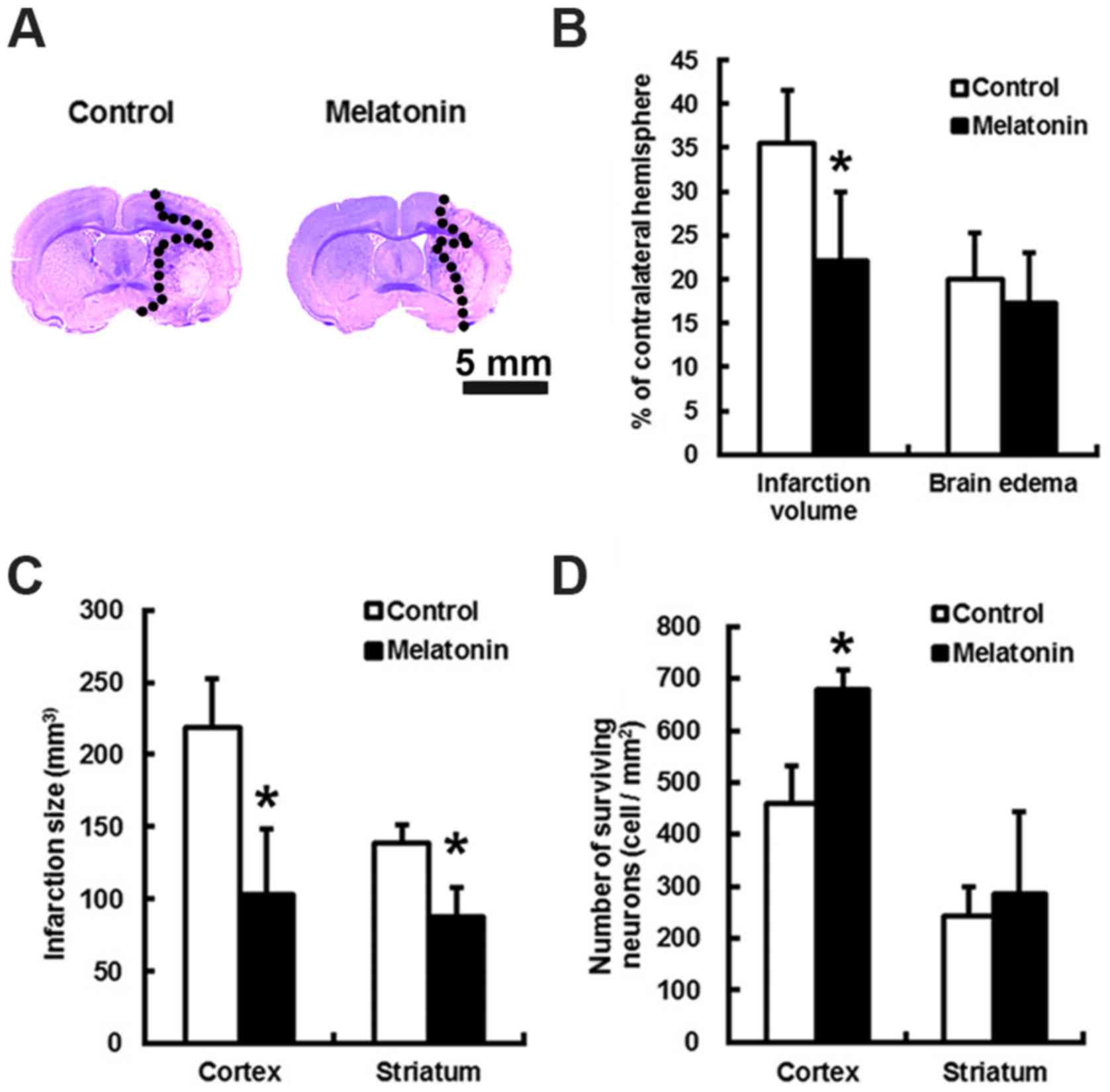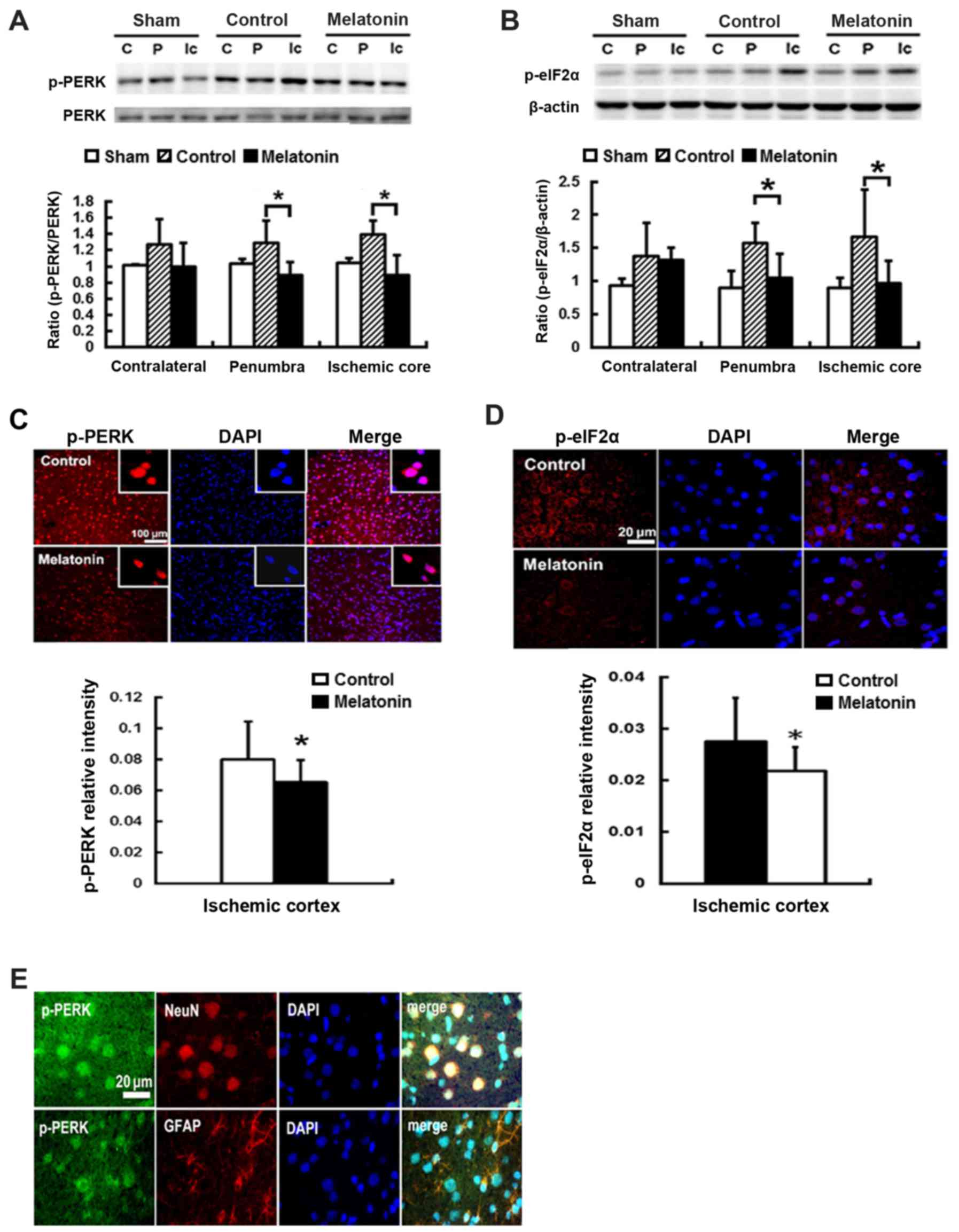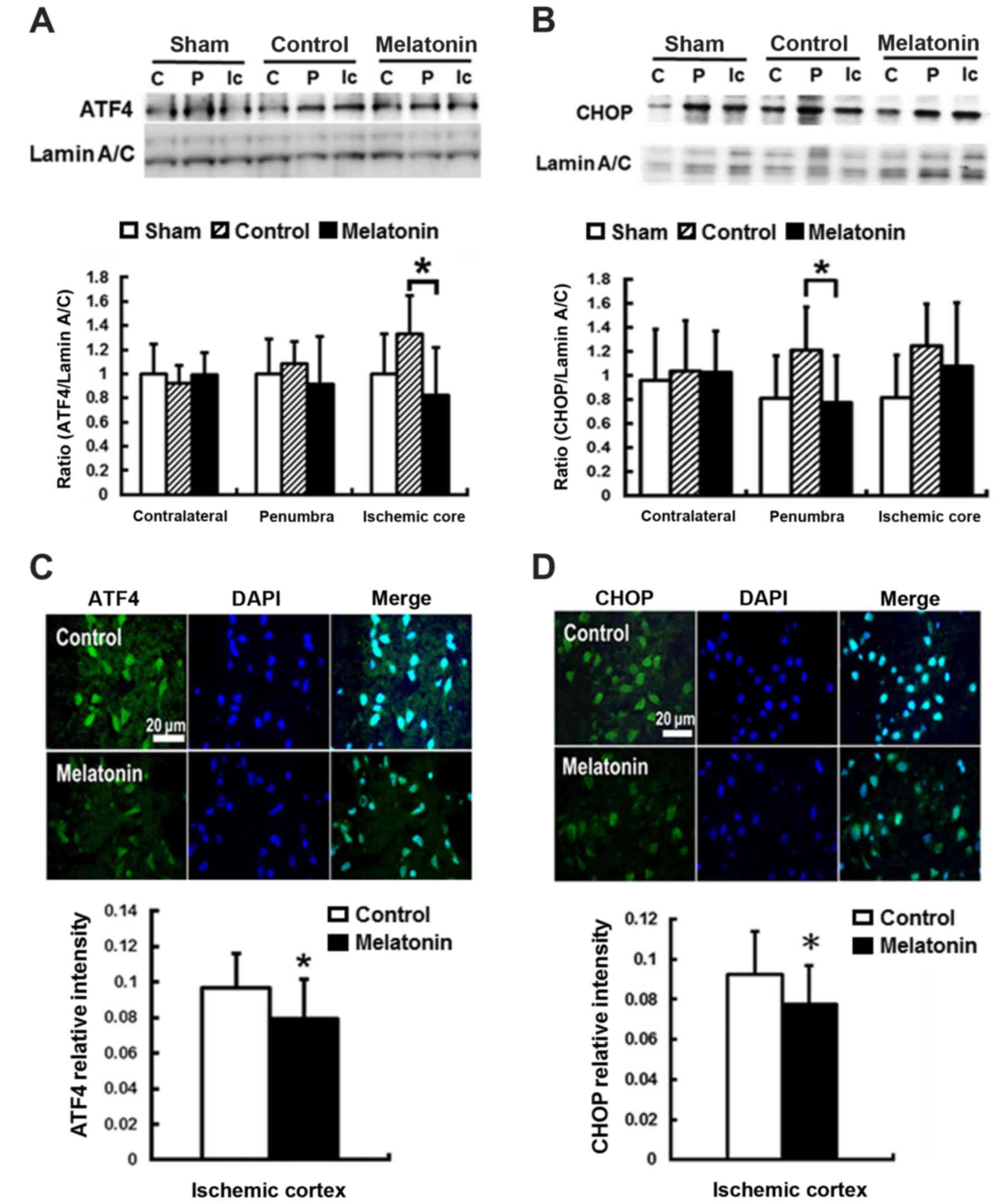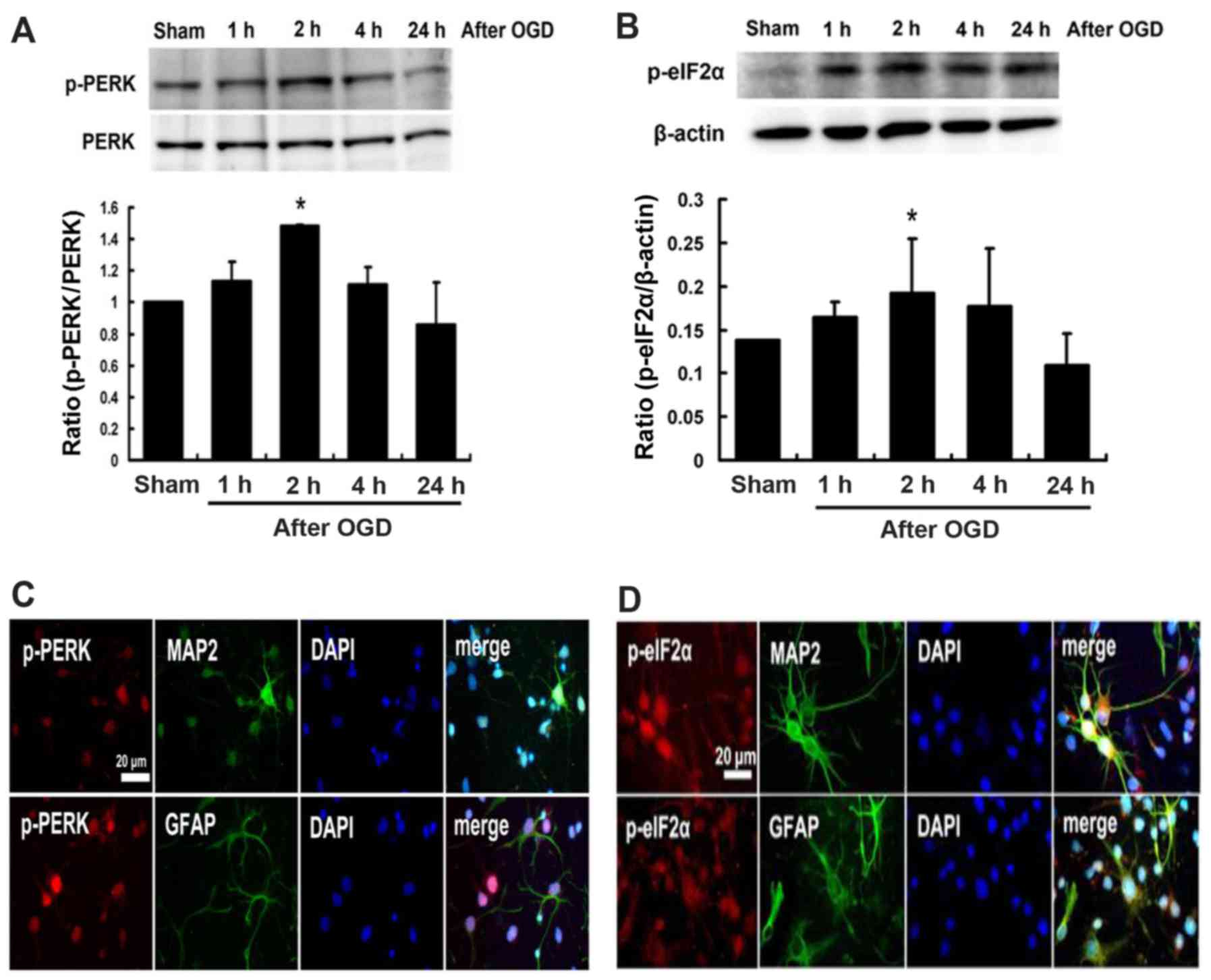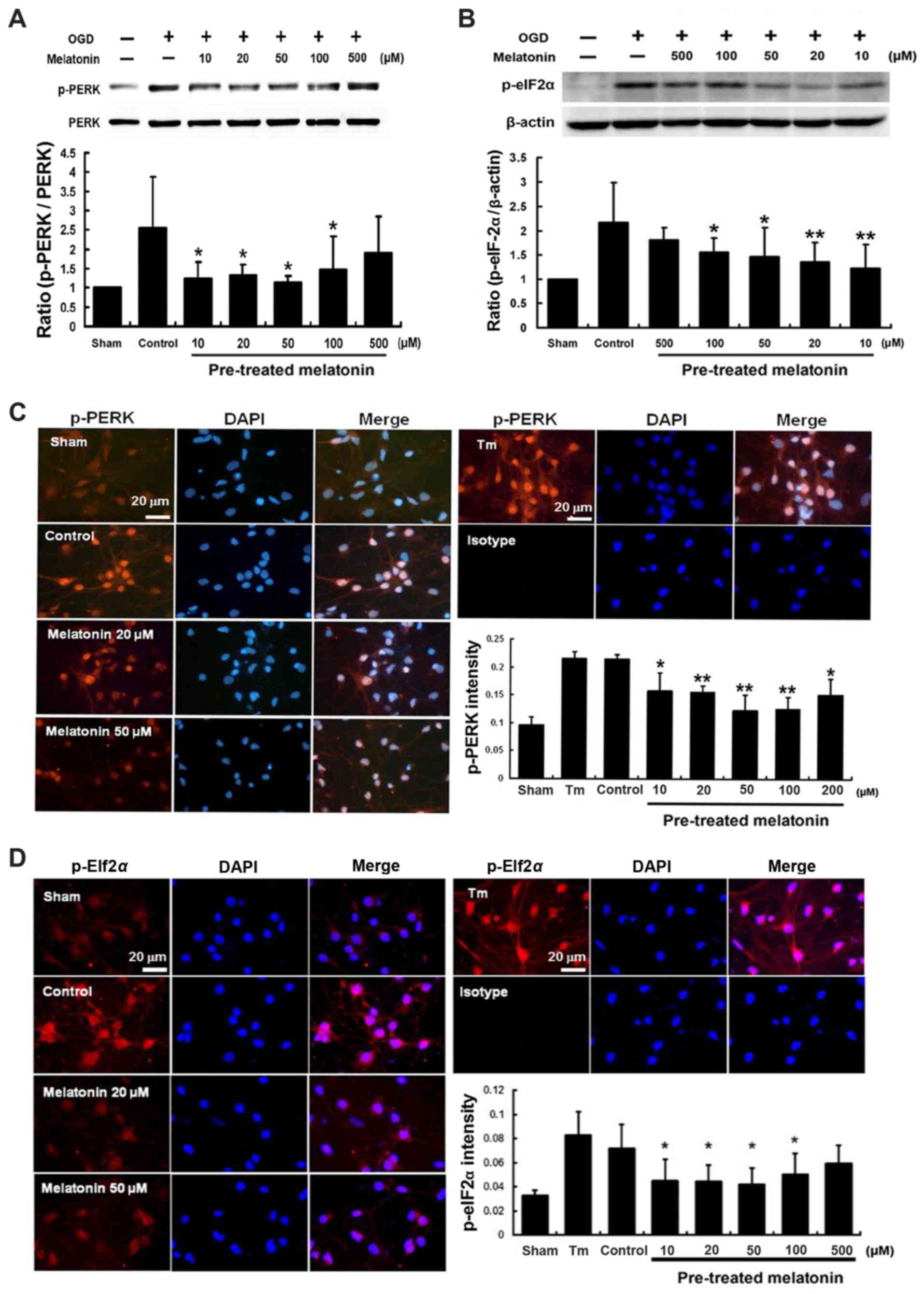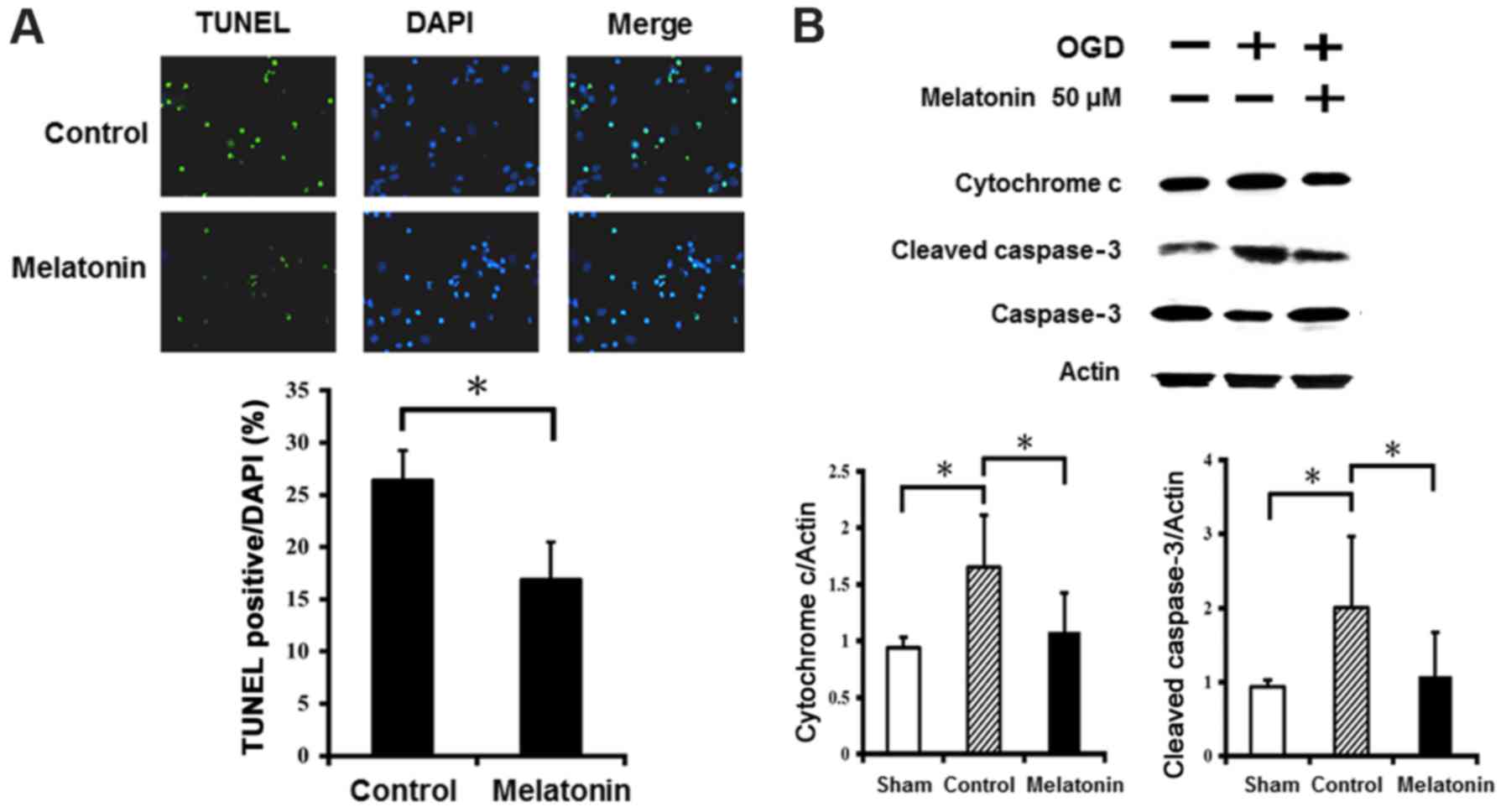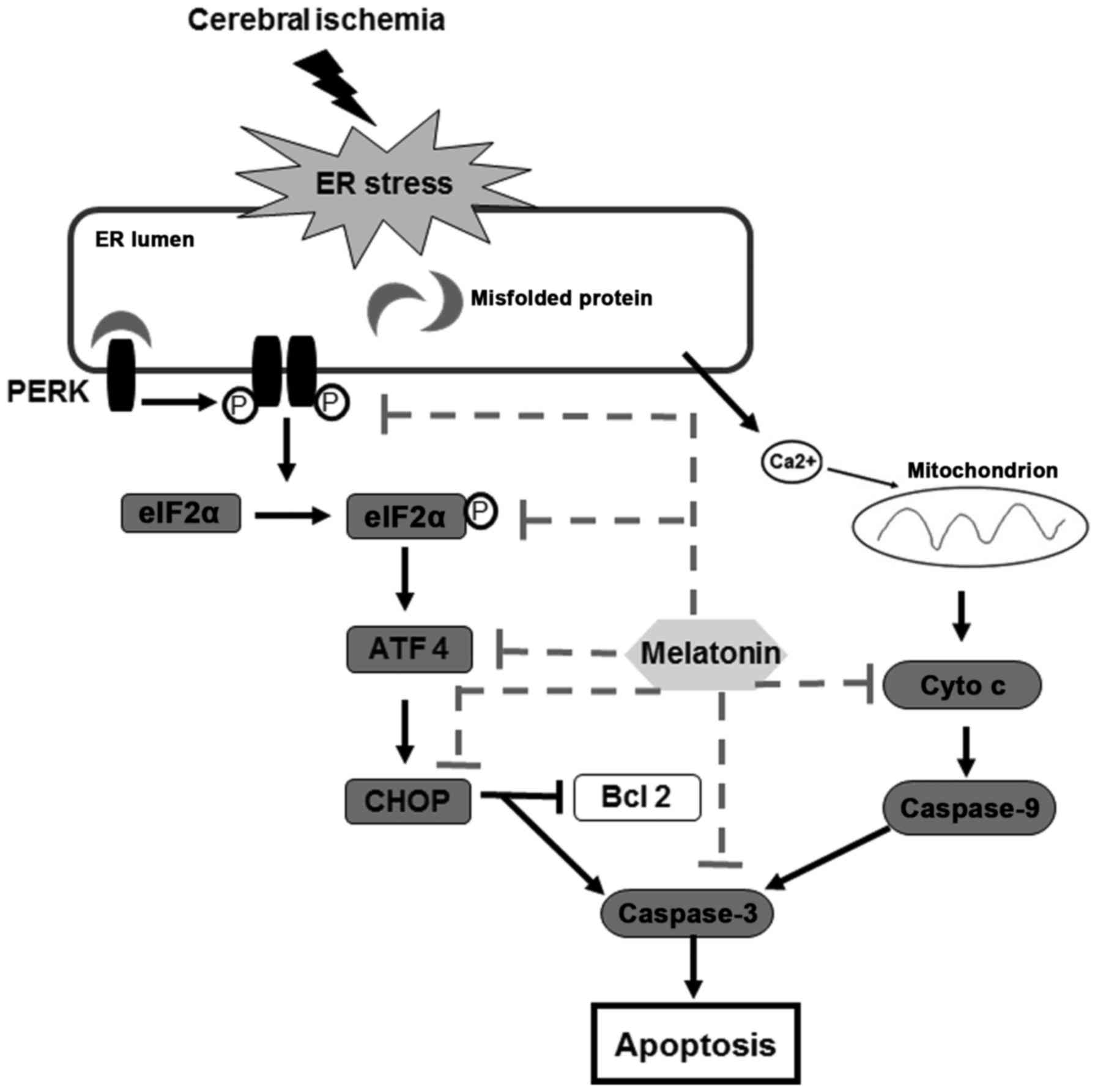|
1
|
Cheung K and Kaufmann P: Efficiency
perspectives on adaptive designs in stroke clinical trials. Stroke.
42:2990–2994. 2011. View Article : Google Scholar : PubMed/NCBI
|
|
2
|
Mantz J, Degos V and Laigle C: Recent
advances in pharmacologic neuroprotection. Eur J Anaesthesiol.
27:6–10. 2010. View Article : Google Scholar
|
|
3
|
Roussel BD, Kruppa AJ, Miranda E, Crowther
DC, Lomas DA and Marciniak SJ: Endoplasmic reticulum dysfunction in
neurological disease. Lancet Neurol. 12:105–118. 2013. View Article : Google Scholar
|
|
4
|
Paschen W: Endoplasmic reticulum
dysfunction in brain pathology: Critical role of protein synthesis.
Curr Neurovasc Res. 1:173–181. 2004. View Article : Google Scholar
|
|
5
|
Chen X, Kintner DB, Luo J, Baba A, Matsuda
T and Sun D: Endoplasmic reticulum Ca2+ dysregulation
and endoplasmic reticulum stress following in vitro neuronal
ischemia: Role of Na+-K+-Cl−
cotransporter. J Neurochem. 106:1563–1576. 2008. View Article : Google Scholar : PubMed/NCBI
|
|
6
|
Nakka VP, Gusain A, Mehta SL and Raghubir
R: Molecular mechanisms of apoptosis in cerebral ischemia: Multiple
neuroprotective opportunities. Mol Neurobiol. 37:7–38. 2008.
View Article : Google Scholar
|
|
7
|
Ferri KF and Kroemer G: Organelle-specific
initiation of cell death pathways. Nat Cell Biol. 3:E255–E263.
2001. View Article : Google Scholar : PubMed/NCBI
|
|
8
|
Tajiri S, Oyadomari S, Yano S, Morioka M,
Gotoh T, Hamada JI, Ushio Y and Mori M: Ischemia-induced neuronal
cell death is mediated by the endoplasmic reticulum stress pathway
involving CHOP. Cell Death Differ. 11:403–415. 2004. View Article : Google Scholar : PubMed/NCBI
|
|
9
|
Qi X, Hosoi T, Okuma Y, Kaneko M and
Nomura Y: Sodium 4-phenylbutyrate protects against cerebral
ischemic injury. Mol Pharmacol. 66:899–908. 2004. View Article : Google Scholar : PubMed/NCBI
|
|
10
|
Sokka AL, Putkonen N, Mudo G, Pryazhnikov
E, Reijonen S, Khiroug L, Belluardo N, Lindholm D and Korhonen L:
Endoplasmic reticulum stress inhibition protects against
excitotoxic neuronal injury in the rat brain. J Neurosci.
27:901–908. 2007. View Article : Google Scholar
|
|
11
|
Paschen W and Doutheil J: Disturbances of
the functioning of endoplasmic reticulum: A key mechanism
underlying neuronal cell injury. J Cereb Blood Flow Metab. 19:1–18.
1999. View Article : Google Scholar : PubMed/NCBI
|
|
12
|
Ma Y and Hendershot LM: The unfolding tale
of the unfolded protein response. Cell. 107:827–830. 2001.
View Article : Google Scholar
|
|
13
|
DeGracia DJ, Kumar R, Owen CR, Krause GS
and White BC: Molecular pathways of protein synthesis inhibition
during brain reperfusion: Implications for neuronal survival or
death. J Cereb Blood Flow Metab. 22:127–141. 2002. View Article : Google Scholar : PubMed/NCBI
|
|
14
|
Hayashi T, Saito A, Okuno S, Ferrand-Drake
M, Dodd RL and Chan PH: Damage to the endoplasmic reticulum and
activation of apoptotic machinery by oxidative stress in ischemic
neurons. J Cereb Blood Flow Metab. 25:41–53. 2005. View Article : Google Scholar : PubMed/NCBI
|
|
15
|
Boyce M and Yuan J: Cellular response to
endoplasmic reticulum stress: A matter of life or death. Cell Death
Differ. 13:363–373. 2006. View Article : Google Scholar : PubMed/NCBI
|
|
16
|
Kim I, Xu W and Reed JC: Cell death and
endoplasmic reticulum stress: Disease relevance and therapeutic
opportunities. Nat Rev Drug Discov. 7:1013–1030. 2008. View Article : Google Scholar : PubMed/NCBI
|
|
17
|
Prostko CR, Brostrom MA and Brostrom CO:
Reversible phosphorylation of eukaryotic initiation factor 2 alpha
in response to endoplasmic reticular signaling. Mol Cell Biochem.
127–128:255–265. 1993. View Article : Google Scholar
|
|
18
|
Ron D: Translational control in the
endoplasmic reticulum stress response. J Clin Invest.
110:1383–1388. 2002. View Article : Google Scholar : PubMed/NCBI
|
|
19
|
Harding HP, Novoa I, Zhang Y, Zeng H, Wek
R, Schapira M and Ron D: Regulated translation initiation controls
stress-induced gene expression in mammalian cells. Mol Cell.
6:1099–1108. 2000. View Article : Google Scholar : PubMed/NCBI
|
|
20
|
Lu PD, Harding HP and Ron D: Translation
reinitiation at alternative open reading frames regulates gene
expression in an integrated stress response. J Cell Biol.
167:27–33. 2004. View Article : Google Scholar : PubMed/NCBI
|
|
21
|
Oida Y, Shimazawa M, Imaizumi K and Hara
H: Involvement of endoplasmic reticulum stress in the neuronal
death induced by transient forebrain ischemia in gerbil.
Neuroscience. 151:111–119. 2008. View Article : Google Scholar
|
|
22
|
Zhao H, Yenari MA, Cheng D, Sapolsky RM
and Steinberg GK: Biphasic cytochrome c release after transient
global ischemia and its inhibition by hypothermia. J Cereb Blood
Flow Metab. 25:1119–1129. 2005. View Article : Google Scholar : PubMed/NCBI
|
|
23
|
Wu CX, Liu R, Gao M, Zhao G, Wu S, Wu CF
and Du GH: Pinocembrin protects brain against ischemia/reperfusion
injury by attenuating endoplasmic reticulum stress induced
apoptosis. Neurosci Lett. 546:57–62. 2013. View Article : Google Scholar : PubMed/NCBI
|
|
24
|
Liu X, Wang M, Chen H, Guo Y, Ma F, Shi F,
Bi Y and Li Y: Hypothermia protects the brain from transient global
ischemia/reperfusion by attenuating endoplasmic reticulum
response-induced apoptosis through CHOP. PLoS One. 8:e534312013.
View Article : Google Scholar : PubMed/NCBI
|
|
25
|
Wang Z, Zhang H, Xu X, Shi H, Yu X, Wang
X, Yan Y, Fu X, Hu H, Li X, et al: bFGF inhibits ER stress induced
by ischemic oxidative injury via activation of the PI3K/Akt and
ERK1/2 pathways. Toxicol Lett. 212:137–146. 2012. View Article : Google Scholar : PubMed/NCBI
|
|
26
|
Lee EJ, Wu TS, Lee MY, Chen TY, Tsai YY,
Chuang JI and Chang GL: Delayed treatment with melatonin enhances
electrophysiological recovery following transient focal cerebral
ischemia in rats. J Pineal Res. 36:33–42. 2004. View Article : Google Scholar
|
|
27
|
Chen HY, Hung YC, Chen TY, Huang SY, Wang
YH, Lee WT, Wu TS and Lee EJ: Melatonin improves presynaptic
protein, SNAP-25, expression and dendritic spine density and
enhances functional and electrophysiological recovery following
transient focal cerebral ischemia in rats. J Pineal Res.
47:260–270. 2009. View Article : Google Scholar : PubMed/NCBI
|
|
28
|
Lee EJ, Lee MY, Chen HY, Hsu YS, Wu TS,
Chen ST and Chang GL: Melatonin attenuates gray and white matter
damage in a mouse model of transient focal cerebral ischemia. J
Pineal Res. 38:42–52. 2005. View Article : Google Scholar
|
|
29
|
Cuzzocrea S, Costantino G, Gitto E, Mazzon
E, Fulia F, Serraino I, Cordaro S, Barberi I, De Sarro A and Caputi
AP: Protective effects of melatonin in ischemic brain injury. J
Pineal Res. 29:217–227. 2000. View Article : Google Scholar : PubMed/NCBI
|
|
30
|
Sun FY, Lin X, Mao LZ, Ge WH, Zhang LM,
Huang YL and Gu J: Neuroprotection by melatonin against ischemic
neuronal injury associated with modulation of DNA damage and repair
in the rat following a transient cerebral ischemia. J Pineal Res.
33:48–56. 2002. View Article : Google Scholar : PubMed/NCBI
|
|
31
|
Lee MY, Kuan YH, Chen HY, Chen TY, Chen
ST, Huang CC, Yang IP, Hsu YS, Wu TS and Lee EJ: Intravenous
administration of melatonin reduces the intracerebral cellular
inflammatory response following transient focal cerebral ischemia
in rats. J Pineal Res. 42:297–309. 2007. View Article : Google Scholar : PubMed/NCBI
|
|
32
|
Kilic E, Kilic U, Yulug B, Hermann DM and
Reiter RJ: Melatonin reduces disseminate neuronal death after mild
focal ischemia in mice via inhibition of caspase-3 and is suitable
as an add-on treatment to tissue-plasminogen activator. J Pineal
Res. 36:171–176. 2004. View Article : Google Scholar : PubMed/NCBI
|
|
33
|
Andrabi SA, Sayeed I, Siemen D, Wolf G and
Horn TF: Direct inhibition of the mitochondrial permeability
transition pore: A possible mechanism responsible for
anti-apoptotic effects of melatonin. FASEB J. 18:869–871. 2004.
View Article : Google Scholar : PubMed/NCBI
|
|
34
|
Jou MJ, Peng TI, Reiter RJ, Jou SB, Wu HY
and Wen ST: Visualization of the antioxidative effects of melatonin
at the mitochondrial level during oxidative stress-induced
apoptosis of rat brain astrocytes. J Pineal Res. 37:55–70. 2004.
View Article : Google Scholar
|
|
35
|
Lee EJ, Lee MY, Chang GL, Chen LH, Hu YL,
Chen TY and Wu TS: Delayed treatment with magnesium: Reduction of
brain infarction and improvement of electrophysiological recovery
following transient focal cerebral ischemia in rats. J Neurosurg.
102:1085–1093. 2005. View Article : Google Scholar : PubMed/NCBI
|
|
36
|
Juan WS, Huang SY, Chang CC, Hung YC, Lin
YW, Chen TY, Lee AH, Lee AC, Wu TS and Lee EJ: Melatonin improves
neuroplasticity by upregulating the growth-associated protein-43
(GAP-43) and NMDAR postsynaptic density-95 (PSD-95) proteins in
cultured neurons exposed to glutamate excitotoxicity and in rats
subjected to transient focal cerebral ischemia even during a
long-term recovery period. J Pineal Res. 56:213–223. 2014.
View Article : Google Scholar
|
|
37
|
Lee WT, Lin MH, Lee EJ, Hung YC, Tai SH,
Chen HY, Chen TY and Wu TS: Magnolol reduces glutamate-induced
neuronal excitotoxicity and protects against permanent focal
cerebral ischemia up to 4 hours. PLoS One. 7:e399522012. View Article : Google Scholar : PubMed/NCBI
|
|
38
|
Lee EJ, Chen HY, Hung YC, Chen TY, Lee MY,
Yu SC, Chen YH, Chuang IC and Wu TS: Therapeutic window for
cinnamophilin following oxygen-glucose deprivation and transient
focal cerebral ischemia. Exp Neurol. 217:74–83. 2009. View Article : Google Scholar : PubMed/NCBI
|
|
39
|
Cimarosti H, Rodnight R, Tavares A, Paiva
R, Valentim L, Rocha E and Salbego C: An investigation of the
neuroprotective effect of lithium in organotypic slice cultures of
rat hippocampus exposed to oxygen and glucose deprivation. Neurosci
Lett. 315:33–36. 2001. View Article : Google Scholar
|
|
40
|
Hung YC, Chen TY, Lee EJ, Chen WL, Huang
SY, Lee WT, Lee MY, Chen HY and Wu TS: Melatonin decreases matrix
metalloproteinase-9 activation and expression and attenuates
reperfusion-induced hemorrhage following transient focal cerebral
ischemia in rats. J Pineal Res. 45:459–467. 2008. View Article : Google Scholar : PubMed/NCBI
|
|
41
|
Chen TY, Tai SH, Lee EJ, Huang CC, Lee AC,
Huang SY and Wu TS: Cinnamophilin offers prolonged neuroprotection
against gray and white matter damage and improves functional and
electrophysiological outcomes after transient focal cerebral
ischemia. Crit Care Med. 39:1130–1137. 2011. View Article : Google Scholar : PubMed/NCBI
|
|
42
|
Chen TY, Lin MH, Lee WT, Huang SY, Chen
YH, Lee AC, Lin HW and Lee EJ: Nicotinamide inhibits nuclear
factor-kappa B translocation after transient focal cerebral
ischemia. Crit Care Med. 40:532–537. 2012. View Article : Google Scholar
|
|
43
|
Ma Y, Brewer JW, Diehl JA and Hendershot
LM: Two distinct stress signaling pathways converge upon the CHOP
promoter during the mammalian unfolded protein response. J Mol
Biol. 318:1351–1365. 2002. View Article : Google Scholar : PubMed/NCBI
|
|
44
|
Zhang K and Kaufman RJ: From
endoplasmic-reticulum stress to the inflammatory response. Nature.
454:455–462. 2008. View Article : Google Scholar : PubMed/NCBI
|
|
45
|
Nakka VP, Gusain A and Raghubir R:
Endoplasmic reticulum stress plays critical role in brain damage
after cerebral ischemia/reperfusion in rats. Neurotox Res.
17:189–202. 2010. View Article : Google Scholar
|
|
46
|
Xin Q, Ji B, Cheng B, Wang C, Liu H, Chen
X, Chen J and Bai B: Endoplasmic reticulum stress in cerebral
ischemia. Neurochem Int. 68:18–27. 2014. View Article : Google Scholar : PubMed/NCBI
|
|
47
|
Tai SH, Hung YC, Lee EJ, Lee AC, Chen TY,
Shen CC, Chen HY, Lee MY, Huang SY and Wu TS: Melatonin protects
against transient focal cerebral ischemia in both reproductively
active and estrogen-deficient female rats: The impact of
circulating estrogen on its hormetic dose-response. J Pineal Res.
50:292–303. 2011. View Article : Google Scholar : PubMed/NCBI
|
|
48
|
Bhandary B, Marahatta A, Kim HR and Chae
HJ: An involvement of oxidative stress in endoplasmic reticulum
stress and its associated diseases. Int J Mol Sci. 14:434–456.
2012. View Article : Google Scholar : PubMed/NCBI
|
|
49
|
DeGracia DJ and Montie HL: Cerebral
ischemia and the unfolded protein response. J Neurochem. 91:1–8.
2004. View Article : Google Scholar : PubMed/NCBI
|
|
50
|
Lange PS, Chavez JC, Pinto JT, Coppola G,
Sun CW, Townes TM, Geschwind DH and Ratan RR: ATF4 is an oxidative
stress-inducible, prodeath transcription factor in neurons in vitro
and in vivo. J Exp Med. 205:1227–1242. 2008. View Article : Google Scholar :
|
|
51
|
Lin JH, Li H, Zhang Y, Ron D and Walter P:
Divergent effects of PERK and IRE1 signaling on cell viability.
PLoS One. 4:e41702009. View Article : Google Scholar : PubMed/NCBI
|
|
52
|
Kohno K, Higuchi T, Ohta S, Kohno K, Kumon
Y and Sakaki S: Neuroprotective nitric oxide synthase inhibitor
reduces intracellular calcium accumulation following transient
global ischemia in the gerbil. Neurosci Lett. 224:17–20. 1997.
View Article : Google Scholar : PubMed/NCBI
|
|
53
|
Tabas I and Ron D: Integrating the
mechanisms of apoptosis induced by endoplasmic reticulum stress.
Nat Cell Biol. 13:184–190. 2011. View Article : Google Scholar : PubMed/NCBI
|
|
54
|
Marciniak SJ, Yun CY, Oyadomari S, Novoa
I, Zhang Y, Jungreis R, Nagata K, Harding HP and Ron D: CHOP
induces death by promoting protein synthesis and oxidation in the
stressed endoplasmic reticulum. Genes Dev. 18:3066–3077. 2004.
View Article : Google Scholar : PubMed/NCBI
|
|
55
|
McCullough KD, Martindale JL, Klotz LO, Aw
TY and Holbrook NJ: Gadd153 sensitizes cells to endoplasmic
reticulum stress by downregulating Bcl2 and perturbing the cellular
redox state. Mol Cell Biol. 21:1249–1259. 2001. View Article : Google Scholar : PubMed/NCBI
|
|
56
|
Hung YC, Chou YS, Chang CH, Lin HW, Chen
HY, Chen TY, Tai SH and Lee EJ: Early reperfusion improves the
recovery of contralateral electrophysiological diaschisis following
focal cerebral ischemia in rats. Neurol Res. 32:828–834. 2010.
View Article : Google Scholar : PubMed/NCBI
|
|
57
|
White BC, Sullivan JM, DeGracia DJ, O'Neil
BJ, Neumar RW, Grossman LI, Rafols JA and Krause GS: Brain ischemia
and reperfusion: Molecular mechanisms of neuronal injury. J Neurol
Sci. 179:1–33. 2000. View Article : Google Scholar : PubMed/NCBI
|
|
58
|
Reinecke S, Lutzenburg M, Hagemann G,
Bruehl C, Neumann-Haefelin T and Witte OW: Electrophysiological
transcortical diaschisis after middle cerebral artery occlusion
(MCAO) in rats. Neurosci Lett. 261:85–88. 1999. View Article : Google Scholar : PubMed/NCBI
|
|
59
|
Enager P, Gold L and Lauritzen M: Impaired
neurovascular coupling by transhemispheric diaschisis in rat
cerebral cortex. J Cereb Blood Flow Metab. 24:713–719. 2004.
View Article : Google Scholar : PubMed/NCBI
|



